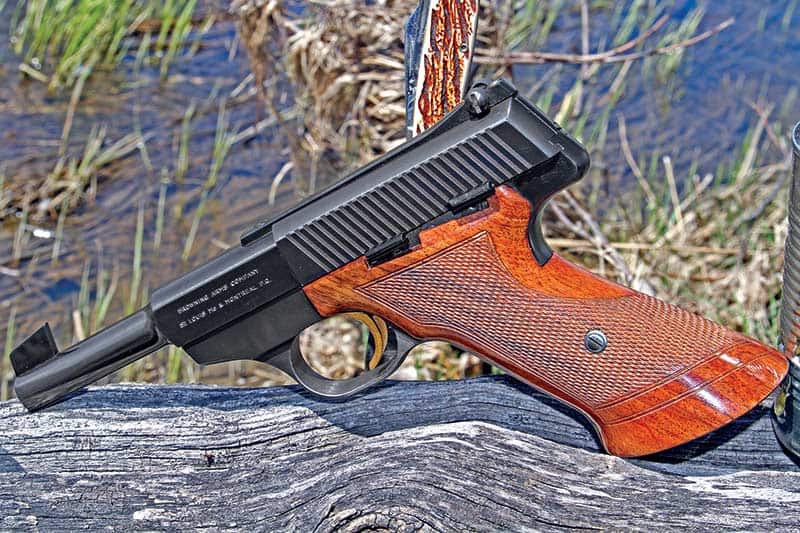Dave remembers when the original Browning Challenger was introduced.
It remains, in his view, the best all-around .22 pistol ever made.
Rimfire pistols and revolvers are among the most useful tools handgunners can own. They are outstanding for training new shooters and maintaining shooting skills. Ammunition is (or was) relatively cheap compared to centerfire ammunition and with virtually no recoil.
They are excellent for pest control and informal small game hunting around a farm or ranch, or to pack while camping, fishing, or hunting big game. But most of all, .22s are fun to shoot.
But What About Carry?
What about .22s as carry guns? I’m not talking about them as backup or last-ditch firearms but as primary personal defense weapons. The short answer is don’t do it. No. End of story.
Except there has to be a story. Yes, any gun is better than no gun. In the vast majority of instances in which a firearm is used defensively, no shots are fired. The person being threatened displays a firearm and the assailant either flees or surrenders. No sensible person wants to be shot. Most foolish people don’t want to be shot either.
The .22LR is no toy. There’s hardly a species on earth that hasn’t at one time or another been killed with a precisely placed .22 bullet. I’ve killed quite a few animals ranging from 300 to 1,200 lbs. with .22 rifles. For years on the farm, we butchered at least two steers and two hogs annually, meat for ourselves and a close relative or two.
Dad didn’t mind shooting vermin from around the barn but found it hard to shoot animals he’d raised. On butchering day, he’d always go to the house for a forgotten knife or sharpening stone, and it was understood the animal would be dead by the time he got back. One shot with the muzzle of the .22 rifle a couple of feet from its head and even a 1,200-lb. steer dropped instantly.
Feeding
Don’t think I don’t have respect for the .22LR cartridge. But I cannot recommend a .22 handgun as a primary defensive arm. There are two fundamental reasons: reliability and power. In a semiautomatic action, the .22LR has two strikes against it. It is a rimmed case, not well adapted to being stacked in box magazines. And it is long for its diameter, making reliable feeding more problematic.
I have many .22 rifles, which have been completely reliable. Almost always, they are models with tubular or rotary magazines. Semiauto .22 rifles I’ve used with complete success include the Winchester 63 and 74, Browning takedown model, Remington Nylon 66 and 550, Marlin 60 and Ruger 10/22, among others. Box magazine semiautos have been less reliable.
The standard Remington Nylon 66 is legendary for its reliability, while the Nylon 77 with a detachable box magazine I once owned was nothing but trouble. Among detachable magazines, the only ones I can recommend unreservedly are the Ruger and Browning rotary design
Ammo Reliability
I believe rimfire ignition is less reliable than centerfire ignition. I’ve had far more misfires with rimfire cartridges. Often, they will fire on a second strike, especially if you rotate the cartridge, so the firing pin strikes a different location. I’ve fired hundreds of thousands of centerfire rounds and can recall only two or three misfires.
There’s very little to go wrong with a centerfire primer other than a missing pellet of priming compound or missing anvil. Quality control is rigorous and the chances of a bad primer are remote. One reason I use Black Hills ammunition whenever possible is they visually inspect every primer before it goes to the loading machines, reducing the chances of a misfire to near zero. The handloader can do likewise by inspecting primers before loading. And do keep your oily fingers from touching the primer. There’s a good chap.
There are reliable .22s, most revolvers, for example. Some semiauto .22 pistols are as reliable as the best centerfires, including, in my experience, the Beretta 70 series, the Ruger .22 model, the S&W, 41 and the Browning Buckmark. I’m sure there are others. But that doesn’t solve the lack of power issue. I’ve conceded the effectiveness of the .22LR with precise shot placement.
Can you achieve such precision on what will likely be a moving target? Can you hit a rolling baseball — make that a golf ball — every time, on-demand, at speed and under great stress? Surviving a gunfight will take all the skill, courage and coolness you can muster, the most effective weapon you can manage and probably a good dose of luck. Unless you have no other choice, don’t handicap yourself with a .22.



